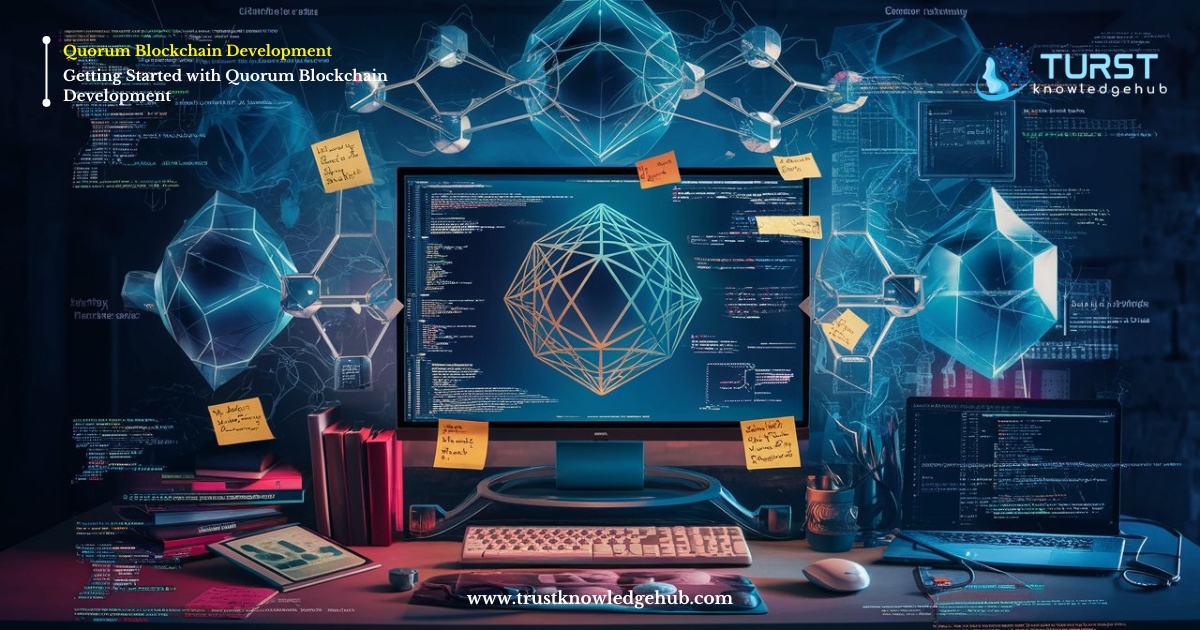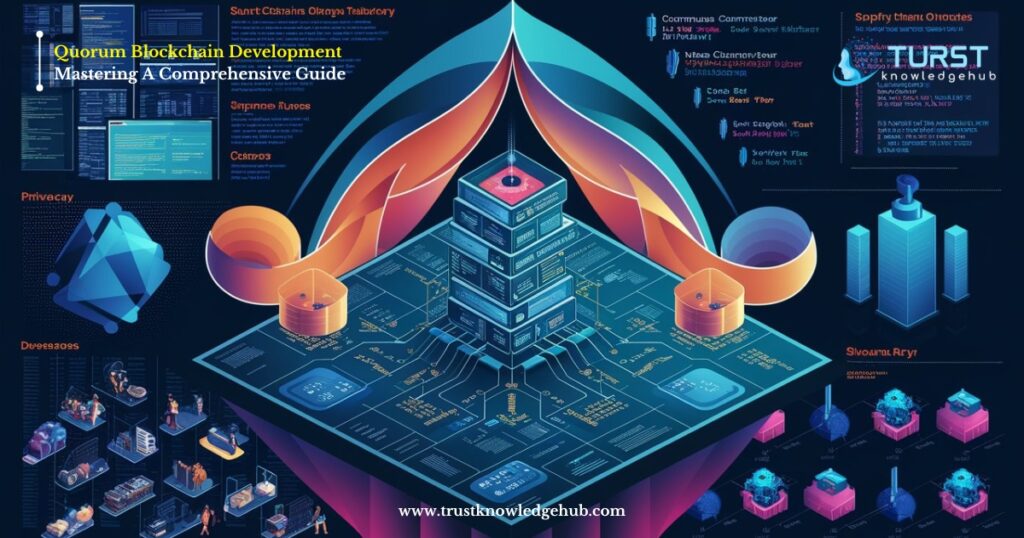This guide on Quorum Blockchain Development will provide readers with a thorough understanding of Quorum’s unique features, practical development techniques, and how it addresses key challenges in blockchain technology, ultimately equipping them with the skills to implement and leverage Quorum effectively for enterprise solutions.
Introduction to Quorum Blockchain Development
What is Quorum Blockchain?
Quorum is an enterprise-focused, permissioned blockchain platform derived from Ethereum, designed to address the specific needs of business and organizational applications. Developed by J.P. Morgan, Quorum combines the robustness of Ethereum’s open-source blockchain with enhancements tailored for private networks, offering a framework where participants have defined permissions and the ability to conduct transactions with confidentiality. The platform maintains Ethereum’s core characteristics—such as smart contracts and decentralized applications—while optimizing it for performance and privacy in a controlled environment.
The Significance of Quorum in Blockchain Technology
Quorum’s significance lies in its dual capability of providing transparency and confidentiality. It caters to enterprises needing a private blockchain that ensures transaction confidentiality while still leveraging the decentralized nature of blockchain technology. By introducing privacy controls and permissions access, Quorum helps organizations comply with regulatory requirements, reduce operational risks, and enhance the integrity of their business processes. Its design underscores a pivotal shift from the public to the private blockchain paradigm, accommodating a broader spectrum of applications in sectors like finance, supply chain management, and healthcare.
Key Features and Benefits of Using Quorum
Quorum distinguishes itself with several key features that cater to enterprise needs. Firstly, it offers privacy through its data partitioning and encryption techniques, allowing confidential transactions and private contracts. Secondly, it provides high throughput and scalability by enabling faster consensus algorithms and optimized block processing. Additionally, Quorum supports customizable consensus mechanisms, allowing organizations to choose or design a consensus protocol that best fits their needs. The platform also benefits from Ethereum’s extensive ecosystem, including its developer tools and smart contract functionality, while offering enhanced security and governance tailored to private networks.
Getting Started with Quorum Blockchain Development

Setting Up Your Development Environment
To embark on Quorum blockchain development, the first step is setting up a suitable development environment. This involves installing the necessary software and tools, configuring your machine, and ensuring compatibility with Quorum’s requirements. A typical setup includes installing Docker for containerization, which simplifies managing Quorum nodes and dependencies. Additionally, configuring an Integrated Development Environment (IDE) like Visual Studio Code or IntelliJ IDEA will streamline your coding and debugging processes. Familiarizing yourself with command-line interfaces and relevant programming languages, particularly Solidity for smart contracts, will also be crucial.
Installing Quorum: A Step-by-Step Guide
Installing Quorum involves several key steps. Begin by downloading the Quorum binaries from the official repository or building them from the source. Next, set up a Quorum network by initializing the genesis block, which defines the initial state and parameters of your blockchain. You will then configure your Quorum nodes, specifying their roles (e.g., validator, participant) and network settings. Running these nodes in Docker containers can streamline the process, allowing for easy deployment and management. Follow the detailed documentation and guides provided by Quorum to ensure a successful installation.
Understanding Quorum’s Core Components
Quorum’s architecture comprises several core components. The Quorum node is the fundamental building block, responsible for validating transactions and maintaining the blockchain. The network layer manages communication between nodes, while the consensus layer determines how transactions are agreed upon and added to the blockchain. Quorum also features a privacy layer, which ensures that transactions can be encrypted and shared only with designated parties. Understanding these components and how they interact is essential for developing and deploying applications on the Quorum platform.
Quorum Blockchain Architecture and Design Principles
Overview of Quorum’s Architecture
Quorum’s architecture integrates several distinct layers to provide a robust framework for enterprise applications. At its base is the Ethereum Virtual Machine (EVM), which executes smart contracts and maintains blockchain state. Above this, Quorum introduces a privacy layer that encrypts transaction data and restricts access to authorized participants. The consensus layer, which can be customized, ensures transactions are validated and blocks are added to the blockchain in a secure and efficient manner. This multi-layered approach enables Quorum to offer both transparency and confidentiality in its operations.
How Quorum Differs from Ethereum and Other Blockchains
Quorum differentiates itself from Ethereum primarily through its focus on privacy and permissioned access. While Ethereum operates as a public blockchain, Quorum is designed for private and consortium networks where participants are known and trusted. This distinction allows Quorum to implement features like private transactions and private contracts, which are not natively available in Ethereum. Furthermore, Quorum offers customizable consensus mechanisms, whereas Ethereum relies on proof-of-work (and is transitioning to proof-of-stake) to achieve consensus. These modifications enable Quorum to better serve enterprise needs for performance and privacy.
The Role of Consensus Mechanisms in Quorum
Consensus mechanisms are pivotal in maintaining the integrity and security of the blockchain. In Quorum, consensus is achieved through protocols tailored for private networks, such as Istanbul Byzantine Fault Tolerance (IBFT) or Raft. These mechanisms ensure that transactions are agreed upon by a majority of nodes, thereby securing the blockchain against malicious attacks and ensuring a consistent state across the network. By allowing customization of consensus algorithms, Quorum enables organizations to select a protocol that aligns with their operational requirements and trust models.
Developing Smart Contracts on Quorum
Writing Smart Contracts in Solidity
Smart contracts on Quorum are developed using Solidity, Ethereum’s programming language. Solidity is a high-level language designed for creating smart contracts that run on the EVM. Writing smart contracts involves defining functions and structures that dictate the behavior of contracts and their interactions with other contracts and external data. Key considerations include ensuring code efficiency, security, and adherence to best practices for contract design. Leveraging Solidity’s features, developers can implement complex business logic and automate transactions on the Quorum blockchain.
Testing and Deploying Smart Contracts on Quorum
Testing smart contracts is crucial to ensure they function as intended and are free from vulnerabilities. Tools like Truffle or Hardhat provide testing frameworks that simulate contract behavior in a controlled environment. Once tested, contracts can be deployed to a Quorum network using deployment scripts and tools like Remix IDE. The deployment process involves compiling the contract code, sending it to the blockchain, and verifying its functionality through interactions. Ensuring comprehensive testing and careful deployment practices will mitigate risks and enhance the reliability of your smart contracts.
Common Challenges and Solutions in Quorum Development
Developing on Quorum presents several challenges, including handling network configuration issues, managing node synchronization, and ensuring privacy. Common issues include difficulty in setting up private transactions or integrating with existing systems. Solutions involve leveraging Quorum’s extensive documentation, engaging with the developer community for support, and employing best practices for debugging and optimization. By addressing these challenges proactively, developers can create robust applications and ensure a smooth development process.
Quorum Nodes and Network Configuration
Configuring Quorum Nodes for Optimal Performance
Configuring Quorum nodes involves tuning parameters to achieve optimal performance and stability. Key considerations include adjusting resource allocations such as CPU and memory, configuring network settings to ensure efficient communication, and setting appropriate block time intervals. Implementing load balancing and redundancy can also enhance performance and reliability. Regular monitoring and performance tuning are essential to maintain an optimal configuration as network conditions and application demands evolve.
Setting Up Private and Consortium Networks
Quorum supports the creation of private and consortium networks, where participants are pre-defined and trusted. Setting up a private network involves configuring nodes with restricted access and permissions, establishing network connectivity, and defining consensus rules. For consortium networks, nodes are managed collaboratively by multiple organizations, requiring coordination on governance and operational policies. Proper setup ensures that the network operates smoothly and meets the requirements of all participating entities.
Managing Node Communication and Synchronization
Effective management of node communication and synchronization is crucial for maintaining blockchain integrity and performance. This involves ensuring that nodes are consistently updated with the latest blockchain state and transactions. Implementing efficient synchronization protocols and monitoring tools can help detect and resolve issues related to node communication. Regular audits and maintenance practices will ensure that nodes remain in sync and perform optimally within the network.
Quorum Consensus Mechanisms
Overview of Quorum’s Consensus Algorithms
Quorum offers several consensus algorithms designed for private and consortium blockchains. Istanbul Byzantine Fault Tolerance (IBFT) is one such algorithm, providing fault tolerance and ensuring consensus even if some nodes fail or act maliciously. Raft is another consensus mechanism used in Quorum, offering a simpler protocol focused on leader-based consensus. These algorithms enhance the reliability and performance of the blockchain by tailoring consensus processes to the specific needs of private networks.
Choosing the Right Consensus Mechanism for Your Project
Selecting the appropriate consensus mechanism depends on factors such as network size, performance requirements, and trust model. IBFT is suitable for networks requiring high fault tolerance and resilience, while Raft may be preferred for smaller, more centralized networks with less stringent fault tolerance needs. Evaluating the trade-offs between different consensus algorithms and aligning them with your project’s objectives will ensure optimal performance and security.
Implementing and Customizing Consensus Protocols
Implementing and customizing consensus protocols in Quorum involves configuring parameters and adapting the protocol to suit your network’s needs. This may include adjusting timeouts, participant thresholds, and other protocol-specific settings. Customization can enhance performance, improve fault tolerance, and tailor the consensus process to specific business requirements. Thorough testing and validation are essential to ensure that custom consensus protocols function correctly and meet the desired objectives.
Security Best Practices in Quorum Blockchain Development
Ensuring Data Privacy and Security
Data privacy and security are paramount in Quorum blockchain development. Implementing strong encryption mechanisms for transaction data and private contracts ensures that sensitive information remains confidential. Regularly updating security protocols and employing access controls to limit data exposure are also crucial. By adhering to best practices in data security, developers can safeguard against potential breaches and ensure the integrity of the blockchain.
Strategies for Protecting Smart Contracts and Transactions
Protecting smart contracts and transactions involves several strategies. Code audits and vulnerability assessments can identify and mitigate potential security issues in smart contracts. Additionally, employing best practices for coding and testing, such as using secure coding standards and conducting thorough testing, can help prevent exploits. Implementing multi-signature transactions and access controls can further enhance security and protect against unauthorized actions.
Regular Security Audits and Best Practices
Conducting regular security audits and following best practices are essential for maintaining a secure Quorum blockchain environment. Audits help identify vulnerabilities and ensure compliance with security standards. Best practices include keeping software updated, monitoring network activity for suspicious behavior, and educating developers on security awareness. By integrating these practices into the development lifecycle, organizations can maintain a robust security posture and protect their blockchain infrastructure.
Integrating Quorum with Existing Systems
API and Middleware Integration
Integrating Quorum with existing systems often involves using APIs and middleware to facilitate communication and data exchange. Quorum provides APIs for interacting with the blockchain, enabling developers to integrate blockchain functionality into existing applications. Middleware solutions can bridge the gap between Quorum and legacy systems, ensuring seamless data flow and operational continuity. Effective integration strategies will enhance the functionality and usability of blockchain applications within existing IT environments.
Interoperability with Other Blockchain Networks
Achieving interoperability with other blockchain networks involves implementing cross-chain communication protocols and standards. Quorum’s flexibility allows for integration with various blockchain platforms, enabling data and transactions to flow between different networks. This interoperability can enhance the functionality of blockchain solutions and support complex multi-chain applications. Leveraging tools and protocols designed for cross-chain communication will facilitate integration and expand the capabilities of your Quorum-based applications.
Case Studies of Successful Integrations
Examining case studies of successful Quorum integrations provides valuable insights into practical applications and implementation strategies. Examples from industries such as finance, supply chain management, and healthcare demonstrate how Quorum has been used to enhance operational efficiency, transparency, and security. Analyzing these cases can offer guidance on best practices and potential challenges, helping organizations to navigate their own integration efforts successfully.
Quorum Development Tools and Libraries
Essential Tools for Quorum Developers
Quorum developers benefit from a range of essential tools that facilitate blockchain development and deployment. Tools such as Truffle and Hardhat provide development frameworks for writing, testing, and deploying smart contracts. Docker simplifies managing Quorum nodes and environments, while monitoring tools help track network performance and health. Utilizing these tools effectively streamlines the development process and enhances productivity.
Leveraging Libraries and Frameworks for Efficient Development
Libraries and frameworks play a crucial role in accelerating Quorum development. Libraries like web3.js enable interaction with the blockchain through JavaScript, while frameworks like Embark provide a comprehensive development environment for building decentralized applications. Leveraging these resources can reduce development time, improve code quality, and facilitate the integration of advanced features.
Advanced Development Tools and Their Use Cases
Advanced development tools offer specialized functionalities for optimizing Quorum blockchain projects. Tools for automated testing, security analysis, and performance profiling help ensure that applications meet high standards of quality and security. Exploring these advanced tools and their use cases can provide developers with additional capabilities and insights for refining their blockchain solutions.
Troubleshooting and Debugging in Quorum Development
Common Issues and Their Solutions
Troubleshooting common issues in Quorum development involves addressing challenges related to node synchronization, network configuration, and contract deployment. Solutions include verifying network settings, examining logs for error messages, and consulting documentation for configuration guidelines. Identifying and resolving issues promptly is essential for maintaining a functional and reliable blockchain environment.
Best Practices for Debugging Quorum Applications
Effective debugging practices include using tools like debuggers and log analyzers to trace issues and identify root causes. Establishing a systematic approach to debugging, such as isolating components and testing them independently, can help pinpoint problems. Regularly reviewing and updating code, as well as conducting peer reviews, can also improve code quality and reduce the likelihood of errors.
Resources for Further Assistance and Support
For further assistance and support, developers can access a variety of resources, including Quorum’s official documentation, developer forums, and community support channels. Engaging with online communities, attending webinars, and participating in developer events can also provide valuable insights and support. Leveraging these resources ensures that developers stay informed and receive assistance when needed.
Real-World Applications and Use Cases of Quorum
Successful Implementations in Various Industries
Quorum has been successfully implemented across various industries, demonstrating its versatility and effectiveness. In finance, Quorum has been used for secure and transparent transactions between financial institutions. In supply chain management, it has facilitated real-time tracking and verification of goods. Healthcare organizations have leveraged Quorum to manage sensitive patient data and streamline administrative processes. These implementations highlight Quorum’s capability to address industry-specific challenges and deliver tangible benefits.
Innovative Use Cases and Future Trends
Innovative use cases for Quorum include applications in digital identity management, regulatory compliance, and decentralized finance (DeFi). As blockchain technology evolves, future trends may include enhanced privacy features, integration with emerging technologies like artificial intelligence, and expanded use in new sectors. Staying abreast of these trends and exploring innovative applications can help organizations leverage Quorum’s capabilities to address evolving business needs.
Lessons Learned from Quorum-Based Projects
Lessons learned from Quorum-based projects provide valuable insights into effective implementation strategies and potential pitfalls. Key lessons include the importance of thorough planning, robust security measures, and effective stakeholder engagement. By analyzing past projects and incorporating these lessons into future initiatives, organizations can improve their blockchain solutions and achieve better outcomes.
Future Trends in Quorum Blockchain Development
Upcoming Features and Enhancements
Upcoming features and enhancements for Quorum may include improvements to scalability, security, and interoperability. Advances in consensus algorithms, enhanced privacy controls, and support for additional blockchain networks are likely areas of focus. Keeping informed about these developments and incorporating new features into your projects will ensure that your Quorum-based solutions remain cutting-edge and relevant.
The Evolving Landscape of Quorum and Blockchain Technology
The landscape of Quorum and blockchain technology is continuously evolving, driven by advancements in technology and shifting industry needs. Emerging trends, such as increased adoption of blockchain in various sectors and the integration of complementary technologies, will shape the future of Quorum development. Staying adaptable and informed about these changes will enable developers to navigate the evolving landscape and leverage new opportunities.
Preparing for the Future of Quorum Blockchain Development
Preparing for the future of Quorum blockchain development involves staying updated on technological advancements, engaging with the developer community, and continuously improving your skills. Embracing innovation, adopting best practices, and being proactive in addressing emerging challenges will position you for success in the evolving world of blockchain technology.
Conclusion and Next Steps
Recap of Key Takeaways in Quorum Blockchain Development
Quorum blockchain development offers a powerful framework for creating secure, private, and scalable blockchain solutions. Key takeaways include understanding Quorum’s unique features, setting up a development environment, and mastering smart contract development. Additionally, effective node configuration, consensus mechanisms, and security practices are crucial for successful implementation.
How to Continue Learning and Growing in Quorum Development
To continue learning and growing in Quorum development, engage with educational resources, participate in online communities, and pursue advanced training opportunities. Experimenting with new features, contributing to open-source projects, and staying updated on industry trends will enhance your expertise and keep you at the forefront of blockchain technology.
Resources and Communities for Quorum Developers
Numerous resources and communities support Quorum developers, including official documentation, online forums, and developer groups. Engaging with these resources can provide valuable knowledge, networking opportunities, and support. By leveraging these tools and communities, you can enhance your development skills and stay connected with the broader Quorum ecosystem.




